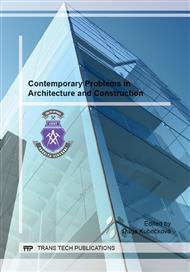p.566
p.573
p.579
p.585
p.591
p.597
p.601
p.605
p.610
Built-In Moisture Process in Structure with Damaged Waterproofing after the Application of Thermal Insulation Boards
Abstract:
The article deals with energy rehabilitation of a building with damaged waterproofing of its lower structure. The reference construction is made of fired bricks, whose functional properties are perfectly fine, but the thermal insulation properties are insufficient for this time. The most common solution of such a problem is the application of a thermal insulating material based on expanded polystyrene on the building envelope. Unfortunately, these solutions often entail the risk of moisture problems in places that appeared to be dry before. The article compares the current solution with the new one relying on material based on calcium silicate [4] with high moisture transport capabilities as an alternative insulation of these buildings.
Info:
Periodical:
Pages:
591-596
Citation:
Online since:
October 2014
Authors:
Price:
Сopyright:
© 2014 Trans Tech Publications Ltd. All Rights Reserved
Share:
Citation:


